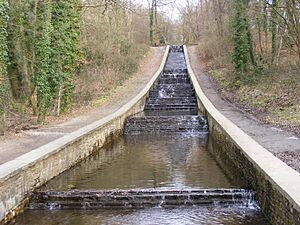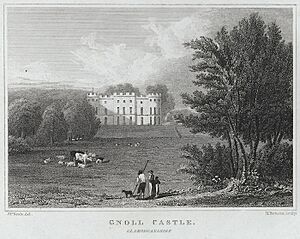Gnoll Country Park facts for kids
The Gnoll Country Park is a beautiful park in Wales. It's like a huge, old garden from the early 1700s, covering more than 100 acres (0.40 km2) (about 0.4 square kilometers). You can find it in the Vale of Neath, which is part of the Neath Port Talbot area in south Wales. It's a great place to explore nature and history!
History of Gnoll Estate
The land where Gnoll Country Park now stands used to be a large private estate. For a long time, in the 1700s and 1800s, it belonged to a family called the Mackworths. People used to say the house on the estate was "one of the finest" in Wales!
Long before the Mackworths, this area was part of lands owned by the Normans, who also built Neath Abbey and Neath Castle. The first known owner of the Gnoll estate was Evan ap David in the 1500s.
Later, in 1686, a man named Humphrey Mackworth married Mary, who was the last descendant of Evan ap David to own the estate. When Mary passed away, Humphrey Mackworth became the owner. He made the house bigger and started many businesses nearby, especially coal mining.
His son, Herbert Mackworth, continued to grow these businesses, including a copper factory. Herbert's son, Sir Herbert Mackworth, 1st Baronet, mined even more coal on the estate.
Over time, the estate changed hands several times. Eventually, in 1923, the town of Neath bought the Gnoll. They wanted to turn it into a place to remember those who served in wars. The old house, sometimes called "Gnoll Castle," was taken down in 1957.
What to See at the Park
Today, Gnoll Country Park is a fun place for everyone! You can walk around the lake or through the woods. There are also cool old features that have been fixed up, like:
- Waterfalls called cascades
- A mysterious grotto (a small cave)
- Four ponds where you can try fishing
- A play area and an adventure playground for kids
The park also has a visitor centre where you can learn about the history of the estate. There's a shop, toilets, and a cafe if you get hungry. It's free to enter the park, but you do need to pay for parking. As you walk around, you might spot the remains of old buildings, like an ice house, a tower, and a fishpond house.
The Famous Hollow Tree
One of the most special spots in the park is the Hollow Tree! It's an old oak tree located close to the visitor centre and the fishpond. This tree is so hollow that kids have been playing inside it for many generations, even since the 1950s!
Even though it's hollow and has metal bars to help support it, the tree still grows leaves and acorns every year. It's a real survivor!
In 2017, the Hollow Tree was chosen as one of the best trees in Wales for the British Tree of the Year competition. It won the Welsh part of the competition with 64% of the votes! This earned the park a £1000 grant to help take care of the tree. Even though it didn't win the overall European competition, it's still a beloved landmark at Gnoll Country Park.



